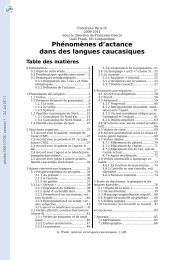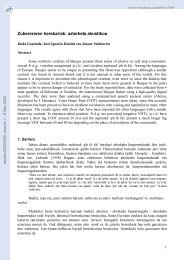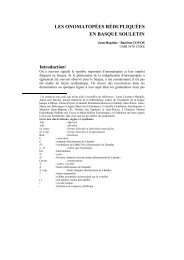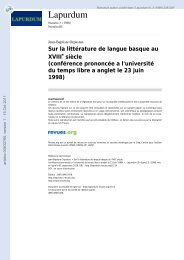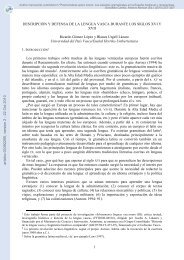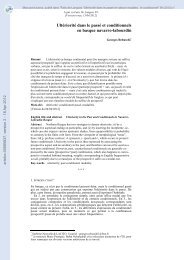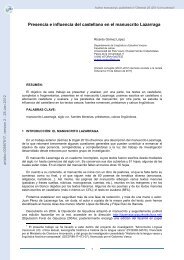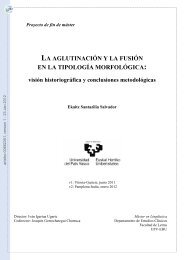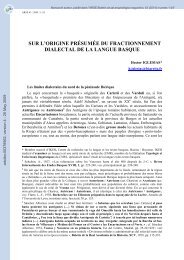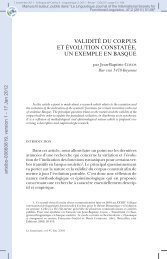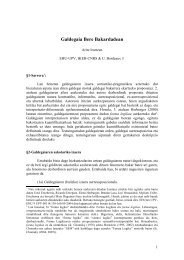On the polysemy of the suffike-ke in the history of Northern Basque
On the polysemy of the suffike-ke in the history of Northern Basque
On the polysemy of the suffike-ke in the history of Northern Basque
You also want an ePaper? Increase the reach of your titles
YUMPU automatically turns print PDFs into web optimized ePapers that Google loves.
artxibo-00494270, version 1 - 22 Jun 2010<br />
482 GEORGES REBUSCHI<br />
(d) A deontic future: ‘Il faudra que tu chantes toi aussi’ ‘You will have to s<strong>in</strong>g<br />
too’ (§ 9) [No counterpart <strong>in</strong> Lk]<br />
Here aga<strong>in</strong>, a periphrasis is used, <strong>in</strong> which behar replaces nahi <strong>of</strong> (c) above, and<br />
<strong>in</strong> which <strong>the</strong> word order varies: <strong>the</strong> lexical verb general follows <strong>the</strong> behar+aux. sequence.<br />
The follow<strong>in</strong>g types are attested:<br />
III: Behar du<strong>ke</strong>k kantatu / kantu eg<strong>in</strong>, with <strong>the</strong> <strong>in</strong>flected aux. <strong>in</strong> <strong>the</strong> -<strong>ke</strong>.<br />
III’: Kantatu behar du<strong>ke</strong>k, id., with <strong>the</strong> lexical verb preced<strong>in</strong>g <strong>the</strong> behar+aux. sequence.<br />
III: Beharko duk kantatu / kantu eg<strong>in</strong>, where prospective -ko is directly suffixed to<br />
behar.<br />
III’: Kantatu beharko duk (same difference with II as <strong>in</strong> I’ vs. I).<br />
III: Behar izanen/ukanen duk kantatu, where <strong>the</strong> verb have is itself submitted to<br />
<strong>the</strong> analytic prospective conjugation.<br />
Here aga<strong>in</strong>, <strong>the</strong>re is a strong contrast between <strong>the</strong> subdialects spo<strong>ke</strong>n <strong>in</strong> Labourd/<br />
Lapurdi and Low Navarre/Behe-Nafarroa, and Soule/Zuberoa. Thus, all <strong>the</strong> direct<br />
translations are <strong>of</strong> type II <strong>in</strong> <strong>the</strong> first two groups <strong>of</strong> dialects, <strong>in</strong> which nei<strong>the</strong>r type I<br />
nor type III are used. In <strong>the</strong> third prov<strong>in</strong>ce, on <strong>the</strong> contrary, <strong>the</strong>re are only 9 translations<br />
<strong>of</strong> type II, but 18 <strong>of</strong> type I, and 7 <strong>of</strong> type III.<br />
(e) A potential future: ‘Vous pourrez aussi prendre des coqs…’ ‘You may [future]<br />
also ta<strong>ke</strong> roosters…’ (§ 7) [No counterpart <strong>in</strong> Lk]<br />
‘Be able/allowed to’ can be rendered with <strong>the</strong> word ahal associated with ei<strong>the</strong>r <strong>the</strong><br />
imperfective, or <strong>the</strong> prospective, participle <strong>of</strong> <strong>the</strong> lexical verb, but also with its radical,<br />
associated with a defective auxiliary suffixe with -<strong>ke</strong>. What is more, double (morphological)<br />
futures are possible, The possibilities are thus much larger than before, but<br />
some trends are clear. (Many texts do not use any means <strong>of</strong> referr<strong>in</strong>g to <strong>the</strong> future).<br />
(i) When only one morpheme is used which can express futurity, it can be: -ko<br />
on ahal (<strong>in</strong> which case <strong>the</strong> lexical verb is is <strong>the</strong> imperfective aspect): hartzen ahalko<br />
d(it)uzue (type I) or -ko/-ren as part <strong>of</strong> <strong>the</strong> prospective participle (<strong>in</strong> which case ahal<br />
rema<strong>in</strong>s unaffected): hartuko ahal d(it)uzue (type II). Type III has -<strong>ke</strong> suffixed to <strong>the</strong><br />
<strong>in</strong>flected verb; <strong>in</strong> typeIV and IV’, it is izan ‘be’ whch is <strong>in</strong> <strong>the</strong> prospective aspect and<br />
associated with an <strong>in</strong>flected form <strong>of</strong> <strong>the</strong> same verb izan used as an auxiliary.<br />
I: Hartzen ahalko d(it)uzue - Lap.: 7 occurrences; B-N: 11; Zub.: 2<br />
II: Hartuko/harturen ahal d(it)uzue - Lap.: 7; B-N: 20; Zub.: 5<br />
III: Hartzen ahal d(it)u<strong>ke</strong>zue - Lap.: none; B-N: 5; Zub.: 17<br />
IV: Hartzen ahal izanen/ukanen d(it)uzue - Lap.: 1; B-N: none; Zub.: none<br />
IV’: Hartu ahal izanen/ukanen d(it)uzue - Lap.: none; B-N: none; Zub.: 2<br />
(ii) There also are three (purely morphological) double futures:<br />
V: Hartuko/harturen ahal d(it)u<strong>ke</strong>zue - Lap.: none; B-N: none; Zub.: 2<br />
VI: Hartuko/harturen ahal izanen/ukanen d(it)uzue - Lap.: none; B-N: none;<br />
Zub.: 1 (Musculdy-Muskildi)<br />
0 ASJU Oyharcabal.<strong>in</strong>dd 482 21/07/09 12:54



